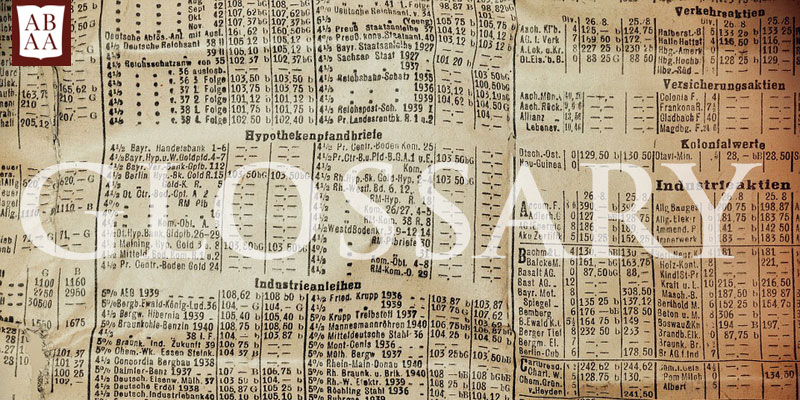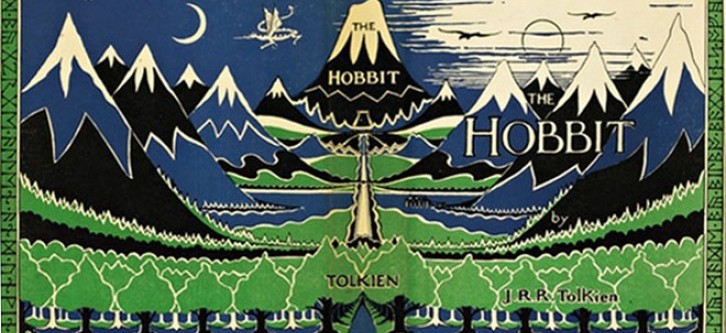One thing that distinguishes the book collector from the casual reader is a preference for owning first editions.
What is a First Edition?
The ABAA Glossary of Book Terms states:
First Edition: “All of the copies printed from the first setting of type; can include multiple printings if all are from the same setting of type.”
Collectors distinguish between a first edition (the first printing of a book) and a modern first edition (which more-or-less applies to books printed from 1900 on -- although, the exact definition is open to debate between dealers).
What is a First Printing?
The first printing is the first batch of books printed from this first setting of type. For a small press, this might be the only printing a book gets, so all copies are first edition, first printings. The ABAA glossary is a master of understatement when it says “Every printed book has a first edition, many never have later editions.” For others, there might be dozens of printings, especially if a book becomes wildly successful. (Witness the recent trend to keep popular young-adult novels -- Veronica Roth’s Allegiant and John Green's Turtles All the Way Down, for two examples -- in hardcover for several years, rather than replace the hardcover with a paperback edition a year after first publication.)
How Can You Tell if a Book is a First Edition?
In general, books before 1900 did not indicate first or subsequent printings. The best way to determine first printings of older books is by the date (usually on the title page), however the practices differed wildly between publishers in this period, so the best advice for pre-1900 books is to consult a reference guide (such as the ones listed at the end of this article) or simply to seek advice from an ABAA member.
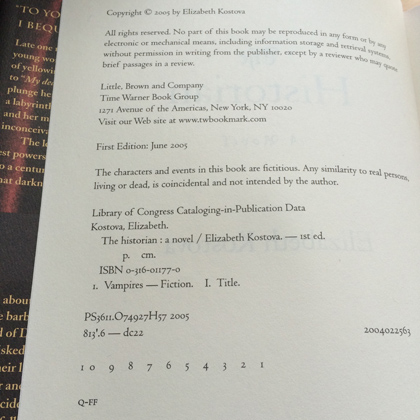
Copyright page for The Historian by Elizabeth Kostova (Little, Brown 2005) indicating a first edition (middle of the image) and first printing (number line at bottom).
When western publishers began indicating printing numbers on the copyright page of their books in the mid-1900s, they adopted various methods. Some print the words "First Printing" on the copyright page of the true first printing, and remove the designation on subsequent printings -- but not all do this. By the later half of the 20th century (as the theory of “mass-market hardcovers” increased the sales numbers of hardcover books), many American and British publishers included a row of numbers on the copyright page to indicate printing:
1 2 3 4 5 6 7 8 9 10
but the order of these numbers varied by publisher. 10 9 8 7 6 5 4 3 2 1 indicates a first printing, as do the same numbers in the opposite order, and oddly so does this configuration with the odd numbers on one side and the even on the other:
1 3 5 7 9 10 8 6 4 2
The unifying factor is that the lowest number indicates the printing, so
3 4 5 6 7 8 9 10 and
10 9 8 7 6 5 4 3 and
3 5 7 9 10 8 6 5 4 all indicate a 3rd printing.
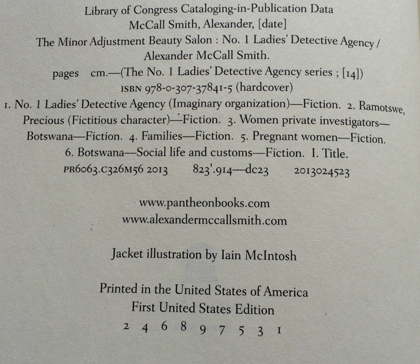
Copyright page for The Minor Adjustment Beauty Salon by Alexander McCall Smith (Pantheon Books, 2013) indicating First United States Edition (original publication being in the UK, the author's home) and first printing using the number line with even numbers to the left and odd to the right.
Just to make things more confusing, some publishers add a year to the printing number (usually seen in best-sellers which were reprinted frequently -- several times per year), leading to lines like this:
88 89 90 91 92 10 9 8 7 6 -- meaning 6th printing in 1988
Unless a collector is seeking to collect one copy of every book published within a certain year, we can assume there will be little interest in specific printings of the huge bestsellers likely to require this notation.
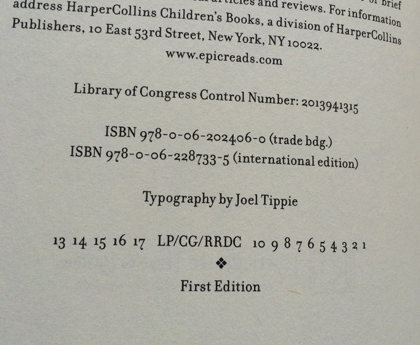
Copyright page for Allegiant by Veronica Roth (Harper Collins, 2013), which indicates the printing number on the right, and optimistically includes year notations on the left (anticipating many and rapid reprints for this hotly anticipated final book in the Divergent Trilogy).
For more information on methods of indicating first editions, see this informative article by ABAA-member Quill & Brush...
The bottom line is beware of placing blind faith in the words "First Edition." Publishers occasionally/frequently (delete according to how charitable you're feeling) leave the "First Edition" or “First Printing” notation on the title page when ordering a new printing. So, if a book’s copyright page says:
First Edition, First Printing
10 9 8 7
it's the 7th printing, not the first.
Exceptions
As every publisher has their own ways of doing things, the above advice serves as a general rule, but doesn't always hold. Confused? Who wouldn't be! Thankfully, there are a number of excellent books by long-time book dealers which detail how individual publishers denote first editions. One of the best is Allen and Patricia Ahearn's Collected Books: The Guide to Values, which includes a trove of information on 19th-century and 20th-century publishers. Another classic is Edward Zempel and Linda Verkler's First Editions: A Guide to Identification. Professional booksellers keep these on hand for reference, as there are simply too many publishers and too many different notations to keep straight otherwise.
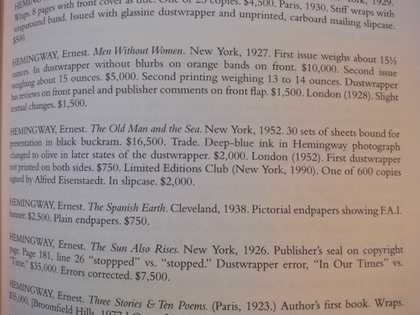
A page from Collected Books: The Guide to Values by Allen and Patricia Ahearn
First State
Most collectors prize the first edition, first printing because it was the way the book first appeared.*
To confuse matters further, a “first state” is a term for the first printed form a book takes (each state referring to a minor change or group of changes to the type or paper). Usually, the first state is the first edition/first printing. However, occasionally errors are caught after the first printing ships. Depending on the severity of the error (one end of the scale comprising a single typo and the other whole chapters of the book being bound in the wrong order!) the whole print run may be pulped and reprinted -- without removing the “first edition” designation. (Publishers, like anyone else, prefer to sweep their mistakes under the carpet.)
If any books have been shipped to stores when this level of error is discovered, they are usually returned immediately, making surviving examples of some first states quite rare indeed! If you collect the unusual, the very rare, or the unique, then certain notorious first states may be of great interest. For example: the first state of Franzen's The Corrections had pages 430 and 431 transposed.
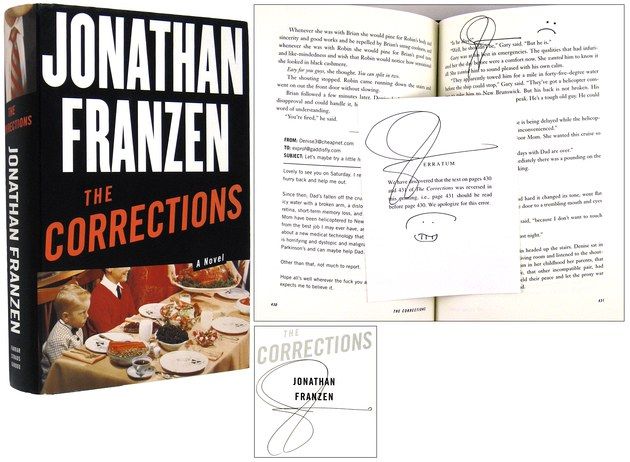
The Corrections by Jonathan Franzen (NY: Farrar Straus Giroux. (2001). The first issue (pages 430 and 431 transposed) of his National Book Award-winner, in the first issue dust jacket, without the Oprah seal. Fine in a fine dust jacket with the slightest crimp to the crown. First Edition. Hardcover. Signed three times by Franzen: once on the title page, once on page 431 (with a frowny face); once on the erratum slip laid in explaining the error (with a smiley face).
This copy was offered by Ken Lopez - Bookseller, but is no longer available.
Most collectors do not get over-excited about first states, but as in any human endeavor, there are purists who pursue first states with a near-religious zeal. The choice of whether first states are something you want to collect depends upon your interests, collecting goals, and budget. Whether first states are "worth it" can be a bone of contention among booksellers and collectors. Famed book collector John Carter, in his classic guide to the terminology of the rare-book world, ABC for Book Collectors, described people who obsess over first states as "Point-Maniacs" -- beginning his page-long analysis of the uselessness of such activity thus: "These are the collectors who do not merely love POINTS but love them to excess." Another phrase he defines is "Issue-Mongers" -- booksellers who focus on first state points for profit's sake, declaring "The issue-monger is one of the worst pests of the collecting world, and the more dangerous because many humble and well-intentioned collectors think him a hero to whom they should be grateful." So, Carter clearly didn't think obsessing over first states was worth his time.
If you do go in for collecting first states, expect to attend a lot of book fairs and get to know a lot of dealers, as advice about, and the "secrets" of, first states are often kept close to the chest. In a market where anyone on eBay can pose as a book dealer, some antiquarian booksellers prefer to share their knowledge with serious collectors in person. Which is why we at the ABAA encourage you to get to know our members. Call a store to talk about a book you are interested in. Ask questions; request pictures. Go to book fairs and get to know antiquarian booksellers. The internet is a convenient method to source books you've been hunting for, but, though we guarantee the authenticity of our members' listings and have built a secure and robust ecommerce site, the internet cannot fully replicate the knowledge-sharing, camaraderie, and trust engendered by meeting dealers face-to-face.
Why Collect First Editions?
There are numerous reasons to collect first editions. Physically, they usually come without irritating "Winner" or "Nominee" stickers with which later printings are often defaced (although some might consider these award nominations an enhancement -- the publishers certainly hope so!), and they are perhaps less likely to be marred by cheap "staff pick" or price stickers. (When I was a bookseller, some of these stickers added by trade book stores used glue that marked the cover, and some publishers occasionally coated their dust jackets with a glossy substance that retained the ghosts of price stickers quite horribly -- I’m looking at you, Penguin Putnam!) But, most collectors simply want a copy of the original, the unassuming book that had not yet won awards, gained notoriety, or climbed the bestseller list. They want a copy of The Great Gatsby before it was “Gatsby!,” a copy of The Satanic Verses before it set the world on fire, or The Corrections before it bore the Oprah seal of approval. Once you have a first edition, first printing of a book you desire, you can do no better -- unless it’s signed, but that’s another story, and one which brings a whole other set of issues with it…).
Thankfully, there are several useful guides that detail the intricacies of first editions, and any book collector, casual or dedicated, will want to read some of these, if not keep them on hand for reference:
Note: Condition generally trumps printing. Unless a book is exceedingly rare, many people will value a later printing in excellent condition over a first edition in tatters (exceptions are made for First Folios and the like...). The presense or absense of a dust jacket can also greatly affect value and desirability.
* (This of course, overlooks ARC/AREs -- Advance Reading Copies/Advance Reading Editions -- which are paperback printings of a soon-to-be-published book distributed free of charge to booksellers and reviewers in the months before a book is officially published. These are often based on proofs (usually corrected, sometimes uncorrected), usually lack illustrations or maps (if any), and may or may not include the final cover art, dedication page, etc. Some people enjoy having these in their collections for curiousity value, but collectors do not consider these the first state.) However, that doesn't mean collectors are not interestted in them, nor that they cannot command high prices, as this very rare set of galley sheets of Harry Potter and the Philosopher's Stone indecates:
Harry Potter and the Philosopher's Stone
by ROWLING, J.K.
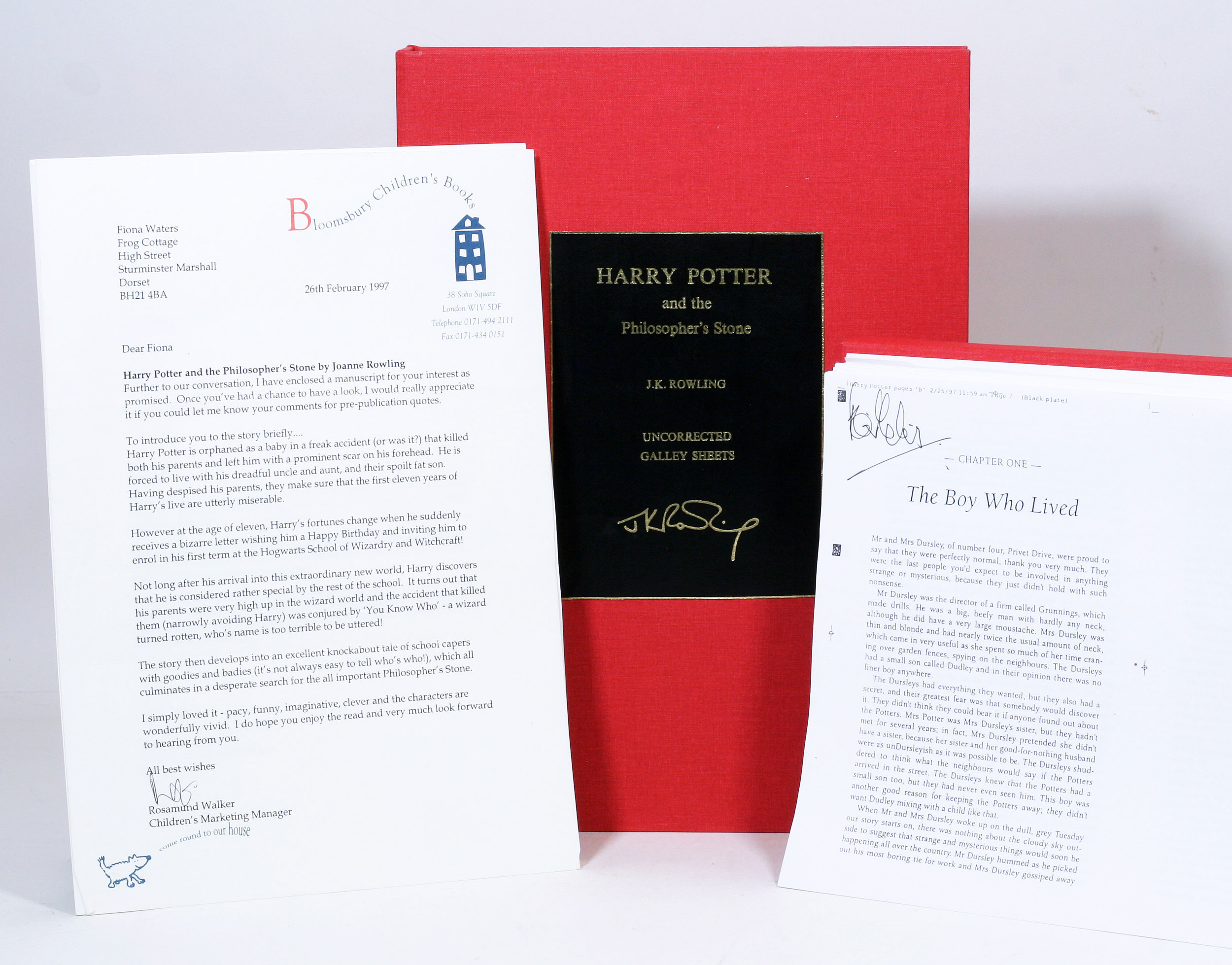
London: Bloomsbury, 1997. First Edition, galley proof. Unbound sheets, housed in custom box. Very Good. EARLIEST KNOWN COPY OF HARRY POTTER; NO OTHER COPIES LOCATED. On February 26, 1997, this remarkable complete set of galley sheets was sent to the distinguished children's author and literary critic Fiona Waters. In the cover letter accompanying the galley (included here), Rosamund Walker, Children's Marketing Manager of Bloomsbury Publishing wrote, "Further to our conversation, I have enclosed a manuscript for your interest as promised. Once you've had a chance to have a look, I would really appreciate it if you could let me know your comments for pre-publication quotes." The "manuscript," already rejected by twelve other publishers, was Harry Potter and the Philosopher's Stone.
Waters read these advance galley sheets during a long train journey to Scotland and was immediately captivated by the tale of a young wizard named Harry Potter. While it was Ms. Waters' usual practice to discard galleys after reading them, she retained this one because she believed Harry Potter was a truly special and distinctive book. She wrote back to Bloomsbury Publishing with effusive praise, making a special point of noting that "There is something about Harry Potter that reminds me of Charlie Bucket in Charlie and the Chocolate Factory." In replying to Waters' letter, Rosamund Walker wrote that "I'm sure the author will be most flattered with the allusion to Charlie Bucket" - and indeed she was: for the statement was featured prominently on the back cover of the first edition.
Historically significant, this is the only known set of advance galley sheets to have survived. It precedes the early June publication of some 200 bound proof copies as well as the first edition that famously appeared on June 26. Intended as they were for prominent reviewers, only a handful of such galleys were produced. Our copy belonged to a lead reviewer whose endorsement undoubtedly helped make the book the spectacular success it became. As Ms. Waters (who signed this galley on the first page) tells it, in recalling her first meeting with J. K. Rowling:
"It was very shortly after the first book was published and I was invited to a party by Bloomsbury to celebrate it all. And when I was introduced to her [J. K. Rowling], she flung her arms around me and said, Oh, you are the lovely lady who gave me that wonderful review!"
Note: By the late 1990s - well into the digital age of printing - publishers generally did not issue traditional galleys printed from a printing press, but rather printed a set of sheets from a file and copied them for distribution to a limited set of reviewers. This is such a copy; any earlier printed appearance has not been discovered and is almost certainly lost to history.
ROWLING, J.K. Harry Potter and the Philosopher's Stone. London: Bloomsbury, February 25, 1997. Galley sheets: 224 numbered pages on 109 sheets [the complete text]. Each sheet with text in landscape format, two pages per sheet (rectos only), time-stamped: 2/25/97 11:59am to 2/25/97 12:16pm. Signed at top in ink by Fiona Waters. WITH: Original signed letter dated 26th February, 1997 from Rosamund Walker introducing the book to Waters; and original signed letter from Walker dated 1 April 1997 thanking Waters for her praise of the book. With Fiona Waters' copy of her letter to Rosamund Walker comparing Harry Potter to Charlie Bucket. Only minor blemishes, generally fine condition. Housed together in a custom box.
The earliest known copy of Harry Potter ever offered for sale.
References:
Fiona Waters quote from conversation by phone with Manhattan Rare Books, March 24, 2023.
Errington, Philip W., J.K. Rowling: A Bibliography, rev. ed. (London: Bloomsbury, 2017).
Offered by The Manhattan Rare Book Company.
Gallery: a few first editions from among our members' current listings:
Things Fall Apart
by CHINUA, ACHEBE
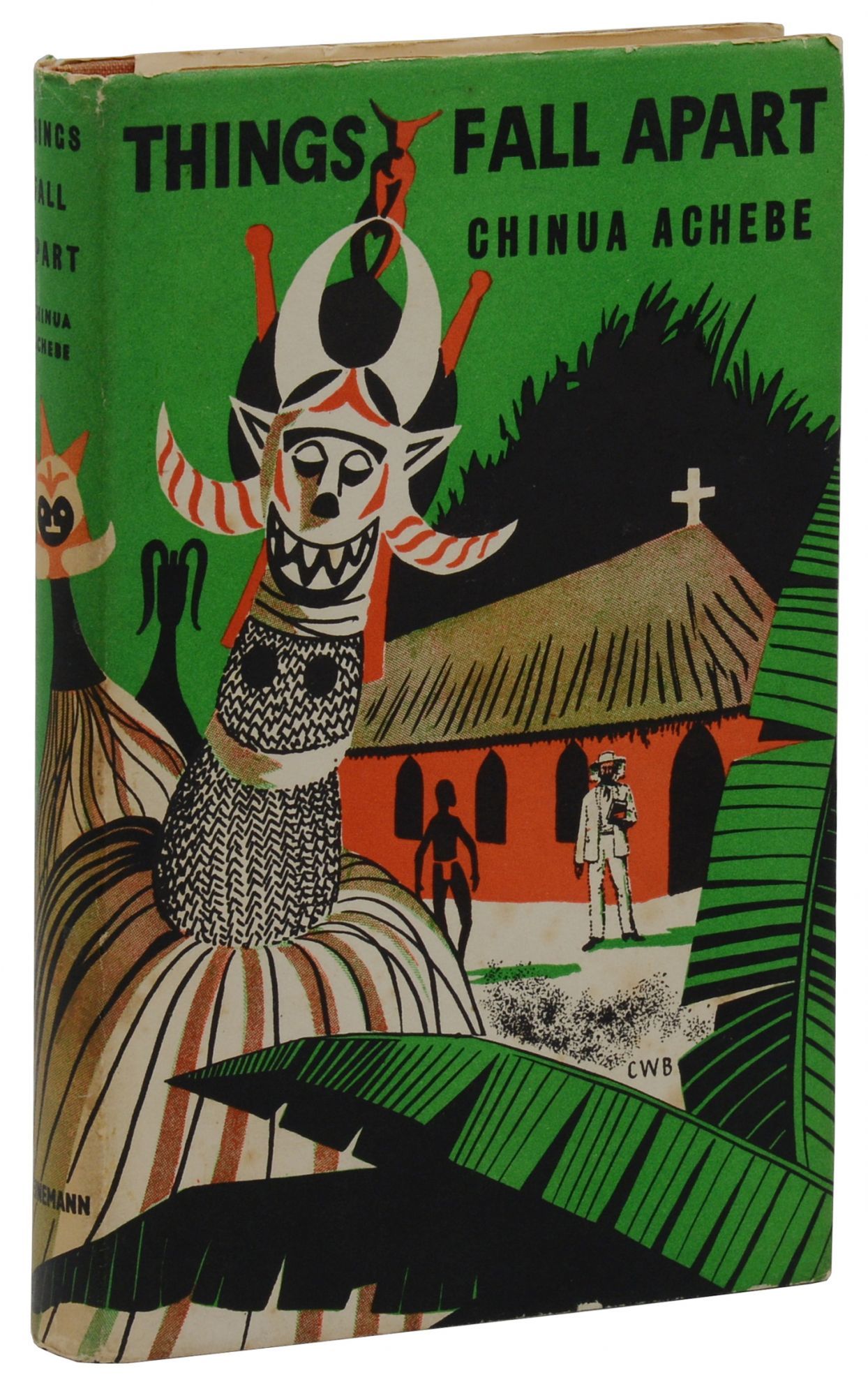
London: William Heinemann, 1958. First Edition. Very Good/Very Good. First edition, first printing. Bound in publisher's red cloth with spine lettered in gilt.. Very Good. Cloth mottled and spine sunned, textblock edge foxed and pages toned. In a Very Good unclipped dust jacket with toning, heavy foxing to the white portions and light creasing to the flaps. The Nigerian novelist Chinua Achebe's magnum opus, the most widely-read modern African novel.
Offered by Burnside Rare Books.
The Catcher In The Rye
by SALINGER, J.D.
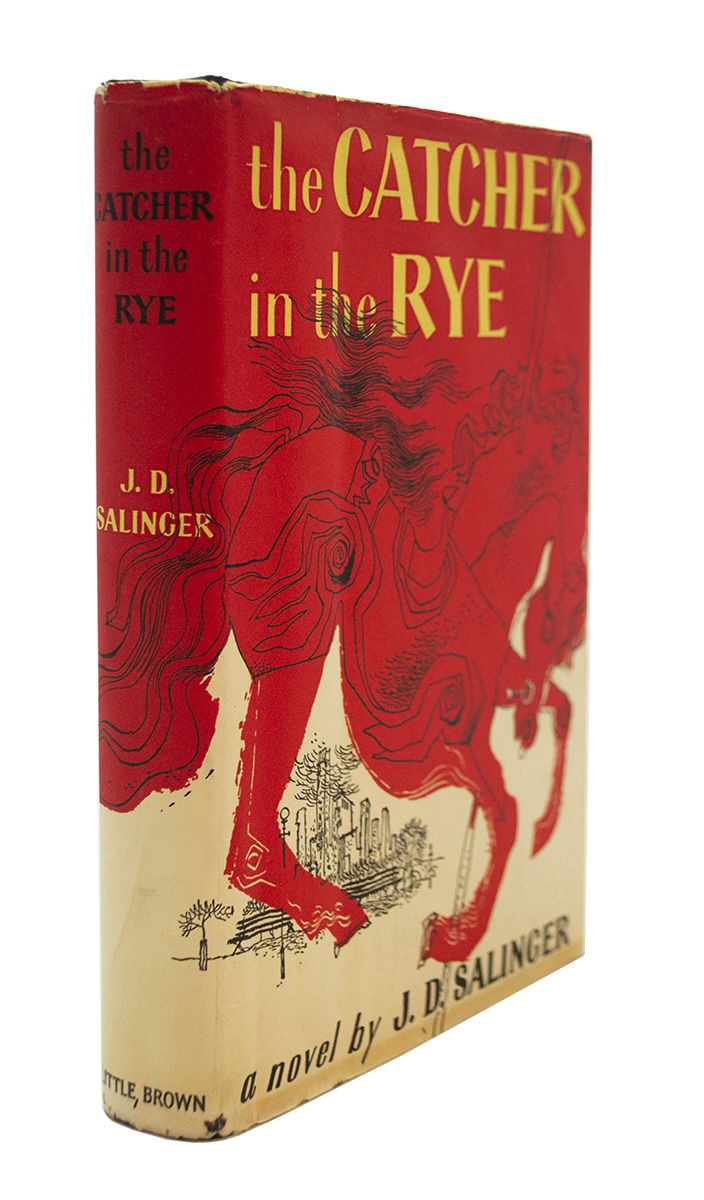
A First Edition of The Catcher in the Rye in Jacket SALINGER, J.D. (1919-2010).
Boston: Little, Brown and Company, 1951. First edition, in first issue dust jacket. Octavo (7 11/16 x 5 1/4 inches; 196 x 135 mm). [8], [1]-277, [1, blank] pp. Publisherís full black cloth. Spine lettered in gilt. Boards with some light glue residue to top and bottom edges. Glue residue from bookplate removal on front and back pastedown. Library stamps for ìBeverly Book Shelves Rental Librariesî on front and back free endpapers as well as to bottom margin of page 71, only touching page number. Some very light soiling to top margin of page 3, not affecting text. In a first issue dust jacket printed in red, black and yellow with cropped photograph of Salinger on rear cover, flap priced at $3.00. Some wrinkling to front panel and small minor chipping along top edge. Some minor toning to bottom edge. Old adhesive remnants to front sides of both flaps and some minor paper damage to inside of flaps. Still a very good copy in a very good, unfaded jacket.
Offered by Heritage Book Shop.
The Professor's House
by Willa Cather
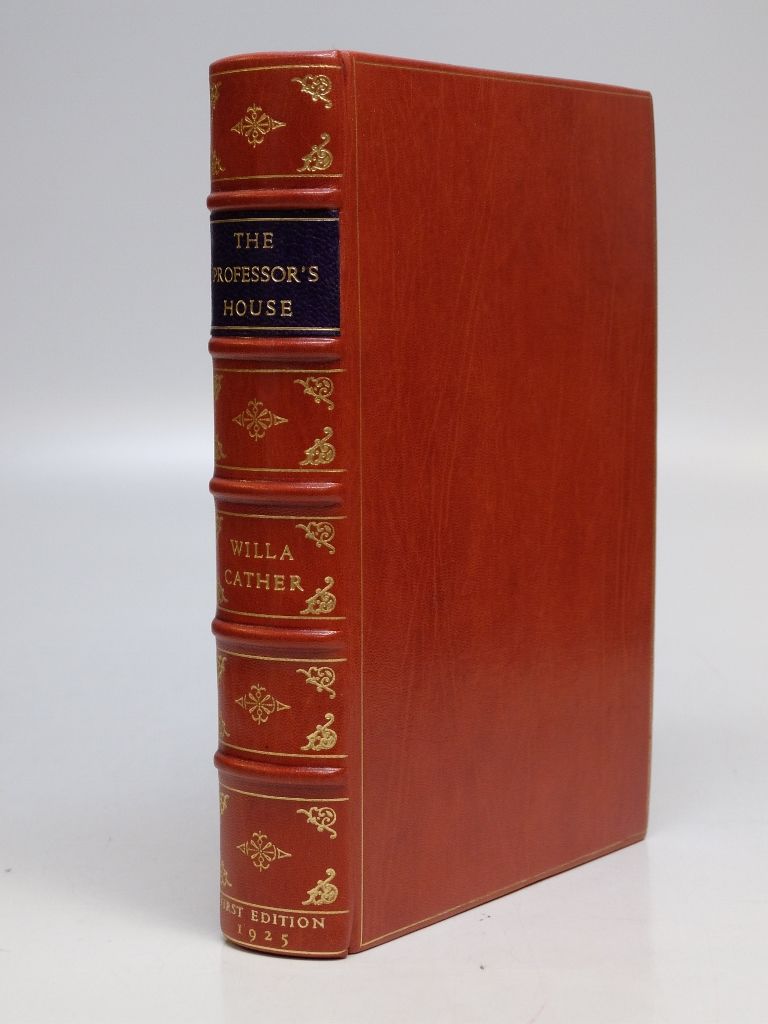
New York: Knopf, 1925. First. hardcover. fine. Tall 8vo, handsomely rebound in full rust morocco; black spine label, ornately gilt spine. New York: Knopf, 1925. First Edition. Fine.
Offered by Argosy Book Store.
Grimus
by RUSHDIE, SALMAN
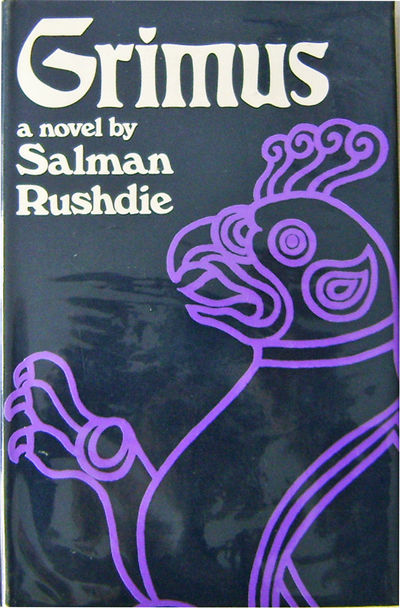
London: Victor Gollanz, 1975. First U.K. Edition. Hardcover. Fine/Fine. First UK and true first edition of the Booker Prize Winning author's first book. A superb collector's copy. Faint erasure mark to front endpaper else a bright clean copy in fine price intact dustwrapper.
Offered by Derringer Books.
SUNSET GUN
by Dorothy Parker
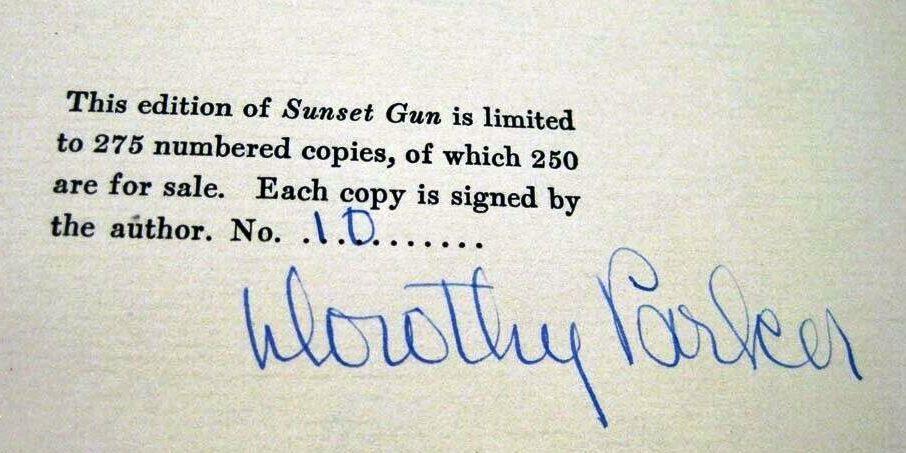
New York: Boni & Liveright, 1928. First Edition. hardcover. Pencil signature on front endpaper. Some uneven fading to the covers with a small bump to the bottom corner of the back cover. Near Fine, lacking the slipcase. Purple boards with a gilt-lettered white cloth spine. Copy #10 of only 275 SIGNED by the poet of this collection of short poems, such as this: SUPERFLUOUS ADVICE
Should they whisper false of you,
Never trouble to deny;
Should the words they say be true,
Weep and storm and swear they lie.
Offered by Charles Agvent.
IF WE TAKE
by BUKOWSKI, CHARLES; [NORSE, HAL]
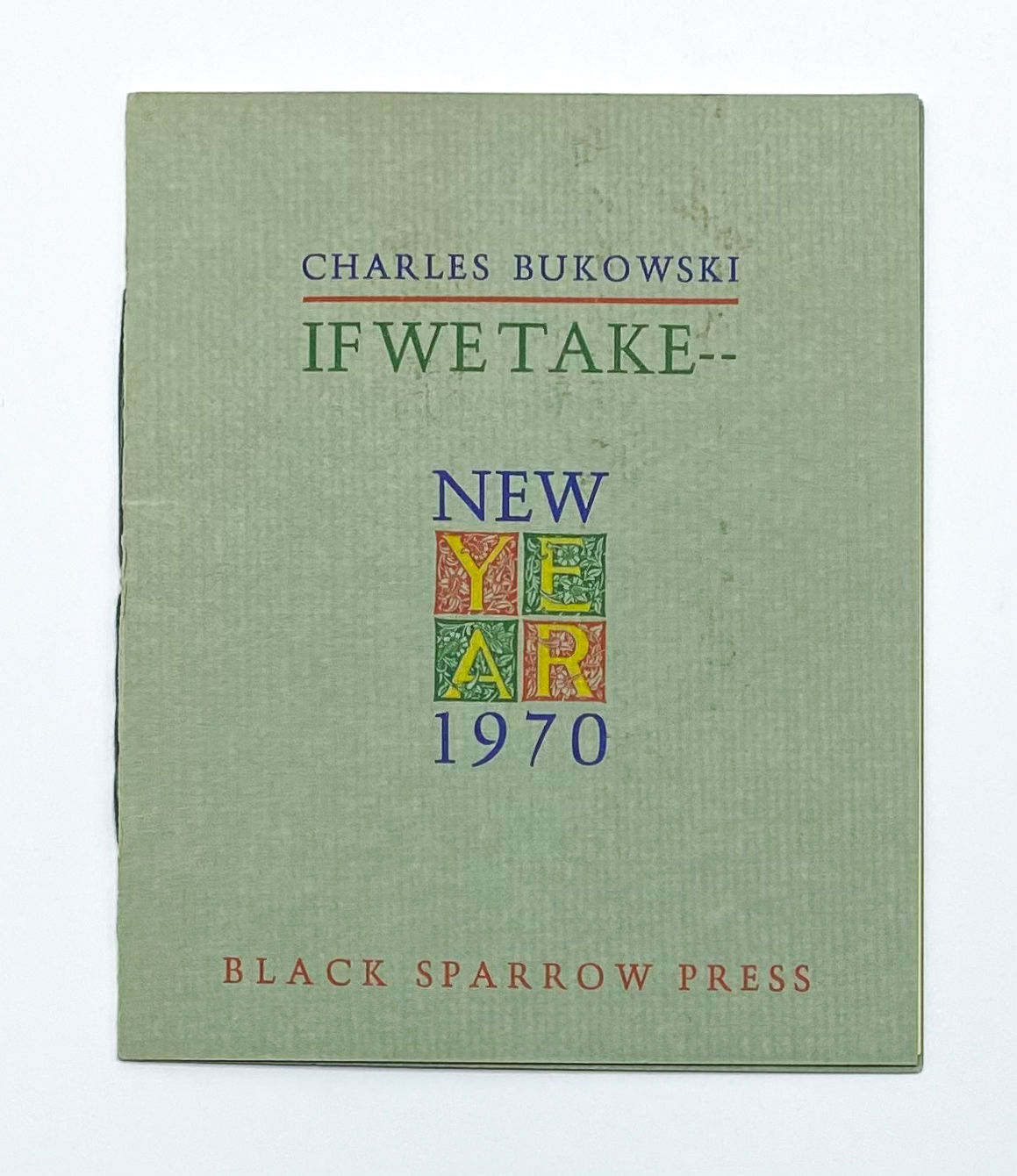
[Los Angeles]: Black Sparrow Press, 1970. Near fine.. First edition, association copy, with an extraordinary inscription and drawing from Bukowski at a pivotal moment in his career to Hal Norse, perennial literary scenester and author of the classic cut-up novel BEAT HOTEL. Norse was a frequent Bukowski correspondent beginning in the mid 1960s, and it was Norse who recommended Bukowski to Penguin Press for their Modern Poets series - then Bukowski's highest-profile appearance to date (they appeared together in the thirteenth installment). But the two didn't meet in person until January of 1969, a little less than a year before this inscription. Norse recalls the experience in his book MEMOIRS OF A BASTARD ANGEL: "I knew that a wild Falstaffian ruffian had come to shake things up with more fiction than fact, more fantasy than truth [...] Bukowski was misshapen [...] He looked [...] during down and out" (p. 420).
Indeed, the poet was down and out, frustrated at his job for the post office and desperate to find a way to support himself from his writing alone. He would find that opportunity later the same year when Black Sparrow publisher John Martin famously offered Bukowski a guaranteed $100 a month for life if he wrote for the press full time. According to Martin, their agreement went into effect January 2nd, 1970 - just six days after this inscription and only a few weeks before Bukowski completed his first novel, POST OFFICE. (IF WE TAKE was the first of many Black Sparrow greetings Bukowski would do for Black Sparrow Press.)
Norse and Bukowski remained life-long - if contentious - friends and correspondents (a collection of their letters has been slated, but delayed, for publication since 2002). Quite simply, one of the closest and warmest Bukowski associations we've seen. 5.5'' x 4.5''. Original string-tied stiff printed wrappers. One of 350 copies. [8] pages. Inscribed by Bukowski to Harold Norse: "12 -27 - 69 / For Hal Norse - / We've both been / through the fire, / dear friend, and / there's more to come - / more fire more o / so much more fire, / and we can only / wonder if we will / kill ourselves first, / or they. No matter - / they will never know. / yrs, / Charles Bukowski." Bukowski has also added to inside of front cover an illustration of a man smoking, signed "Buk." Touches of rubbing, soil. Well preserved.
Offered by Brian Cassidy Bookseller at Type Punch Matrix.
Laura
by Vera Caspary

Boston: Houghton Mifflin Company, 1943. Hardcover. Good/Good. First edition. A bit cocked, small tears and light fraying at the crown, a good copy in a price-clipped good later issue dustwrapper which is sunned at the spine and has some chipping on the front panel. An exceptional association copy of this title. Inscribed by Caspary in the year of publication to George and Miriam Sklar: "For Miriam and George - who feed and shelter me, sympathize with me in my worst moods, listen to my beefs, and still collaborate, with my best, first-class, grade-A love - Vera Jan. 21, 1943." The Sklars were very close to Caspary. George Sklar was a leftist playwright and novelist and the co-author with Caspary of the play adaptation of *Laura,* as well as several other plays. One of the scarcest film source books, basis for the classic 1944 film directed by Otto Preminger (and Rouben Mamoulian) and starring Gene Tierney, Dana Andrews, Vincent Price, and Clifton Webb. The film is reportedly to be remade. The only significant association copy we've ever seen offered for sale.
Offered by Between the Covers Rare Books.
Cane
by TOOMER, JEAN; WALDO FRANK [FOREWORD]
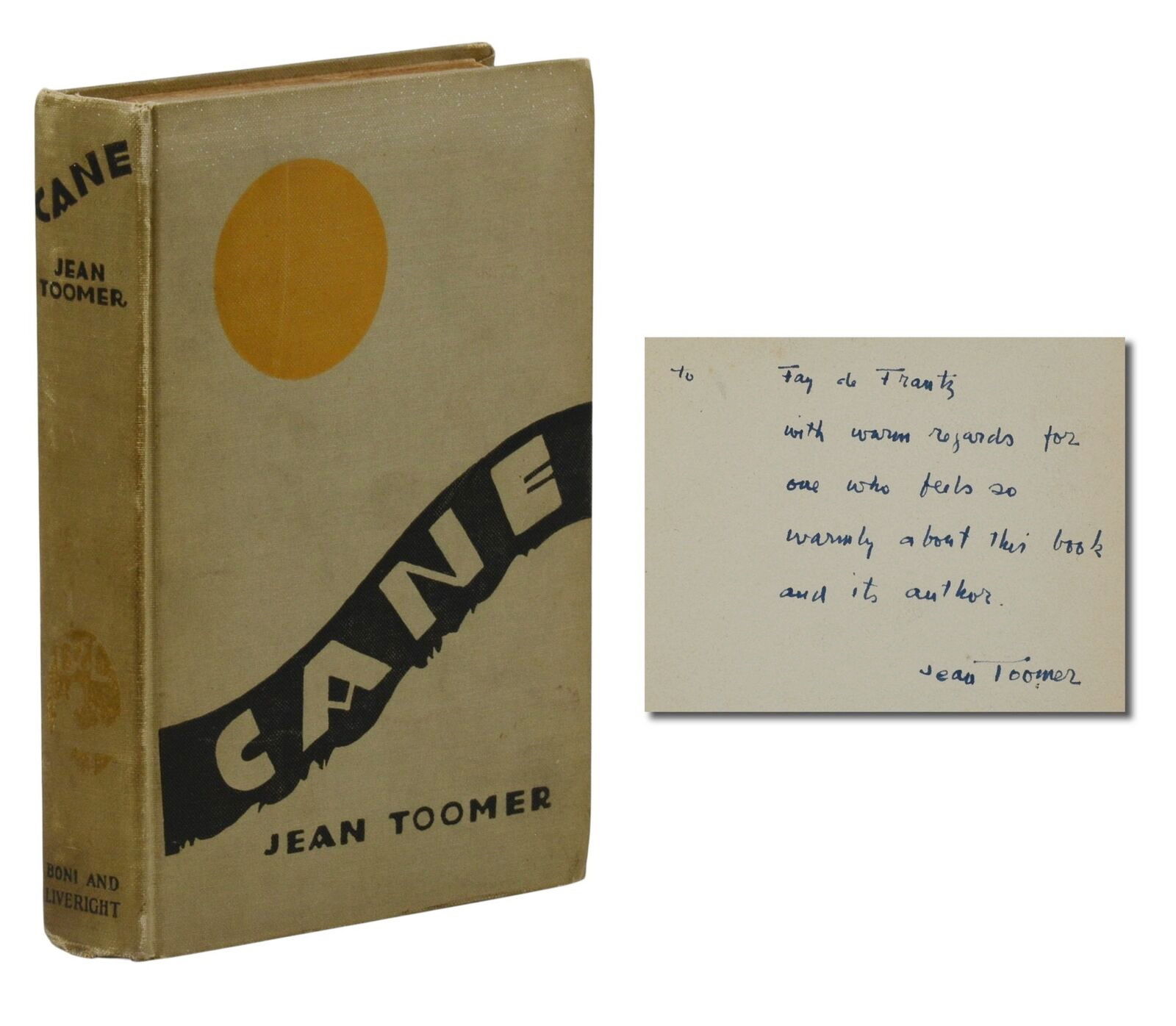
New York: Boni & Liveright, 1923. First Edition. Very Good. First edition, first printing of the classic Harlem Renaissance novel. Extremely rare, signed by Jean Toomer and inscribed to a former owner on the front free endpaper, "To Fay De Frantz with warm regards for one who feels so warmly about this book and its author [signed] Jean Toomer". Bound in publisher's buff cloth stamped in yellow and black; lacking the scarce dust jacket. Very Good with light lean to binding, light soiling and wear to cloth. Pages tanned, small tear and crease to the top of the front free endpaper, several margins show chips or short mended tears at the fore edge. Glue repair to hinge at rear pastedown and evidence of removal of an old bookseller ticket with offsetting to the rear free endpaper. The first appearance of a classic of modern American fiction and pinnacle of the Harlem Renaissance. In his foreword Waldo Frank dubs it "a harbinger of the South's literary maturity: of its emergence from the obsession put upon its mind by the unending racial crisis-an obsession from which writers have made their indirect escape through sentimentalism, exoticism, polemic, 'problem' fiction, and moral melodrama. It marks the dawn of direct and unafraid creation." Signed copies are incredibly scarce.
Offered by Burnside Rare Books.
Make Way for Ducklings
by MCCLOSKEY, ROBERT
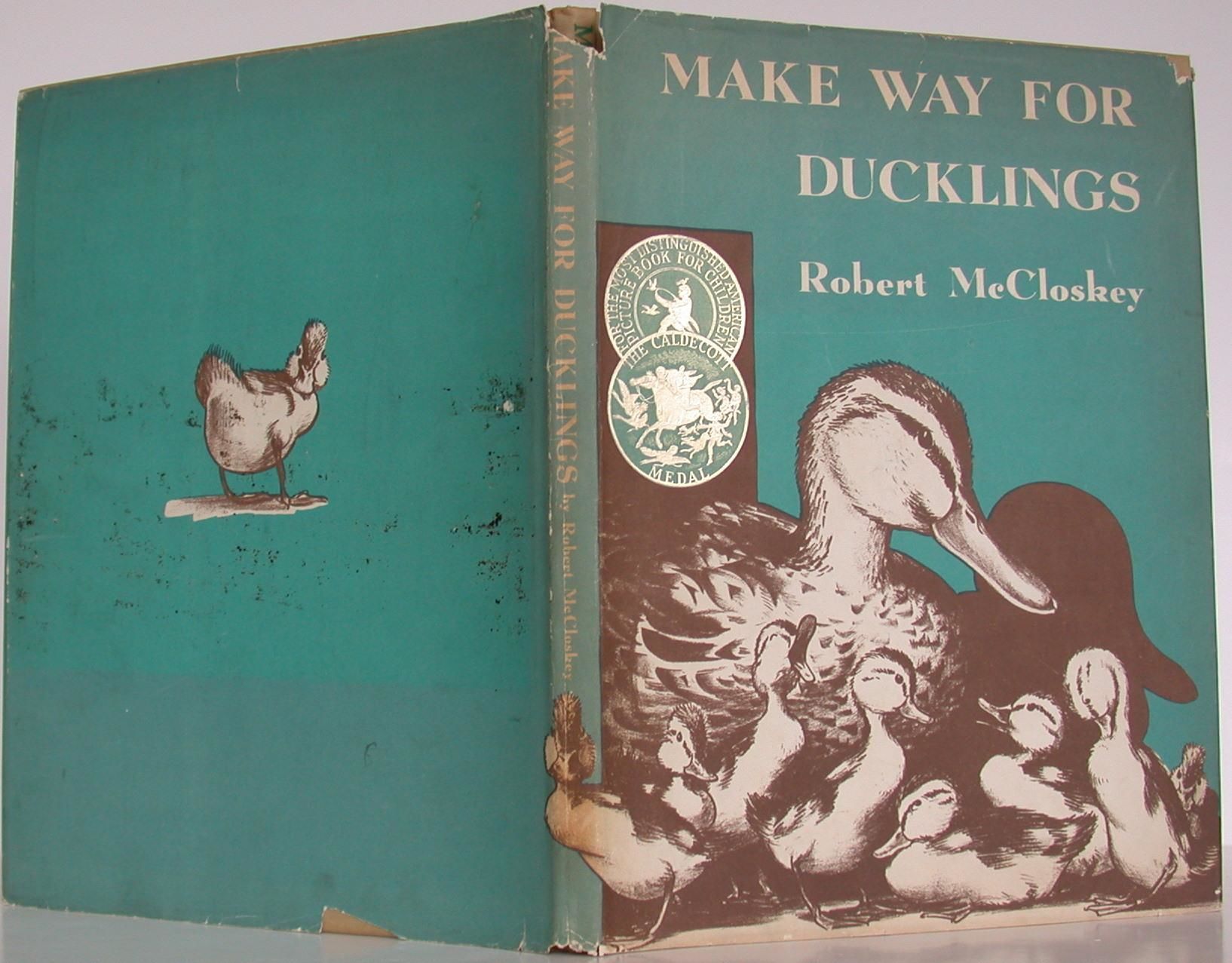
New York: Viking Press, 1941. 1st Edition. Hardcover. Near Fine/Very Good. A true first edition in a first edition first issue dust jacket, with First Published August 1941 stated on the copyright page and no mention of the Caldecott Medal on the front flap of the dust jacket. The reference to the Medal was printed on the front flap of the dust jacket of the second printing. The Medal has been affixed to the front of the first issue dust jacket, which still has the first issue price of $2.00 on the front flap. A near fine book in a very good dust jacket with a small chip at the top of the spine, as shown in the photograph. Housed in a custom-made collector's clamshell case with leather spine with gold gilt lettering and decoration. Perhaps the rarest, most important and most desired of all the Caldecotts. A remarkably scarce book, read to death by or to children, and especially beloved in Boston, where the ducks are commemorated in bronze statues in the Public Garden.
Offered by Bookbid.
Finnegans Wake
by James Joyce
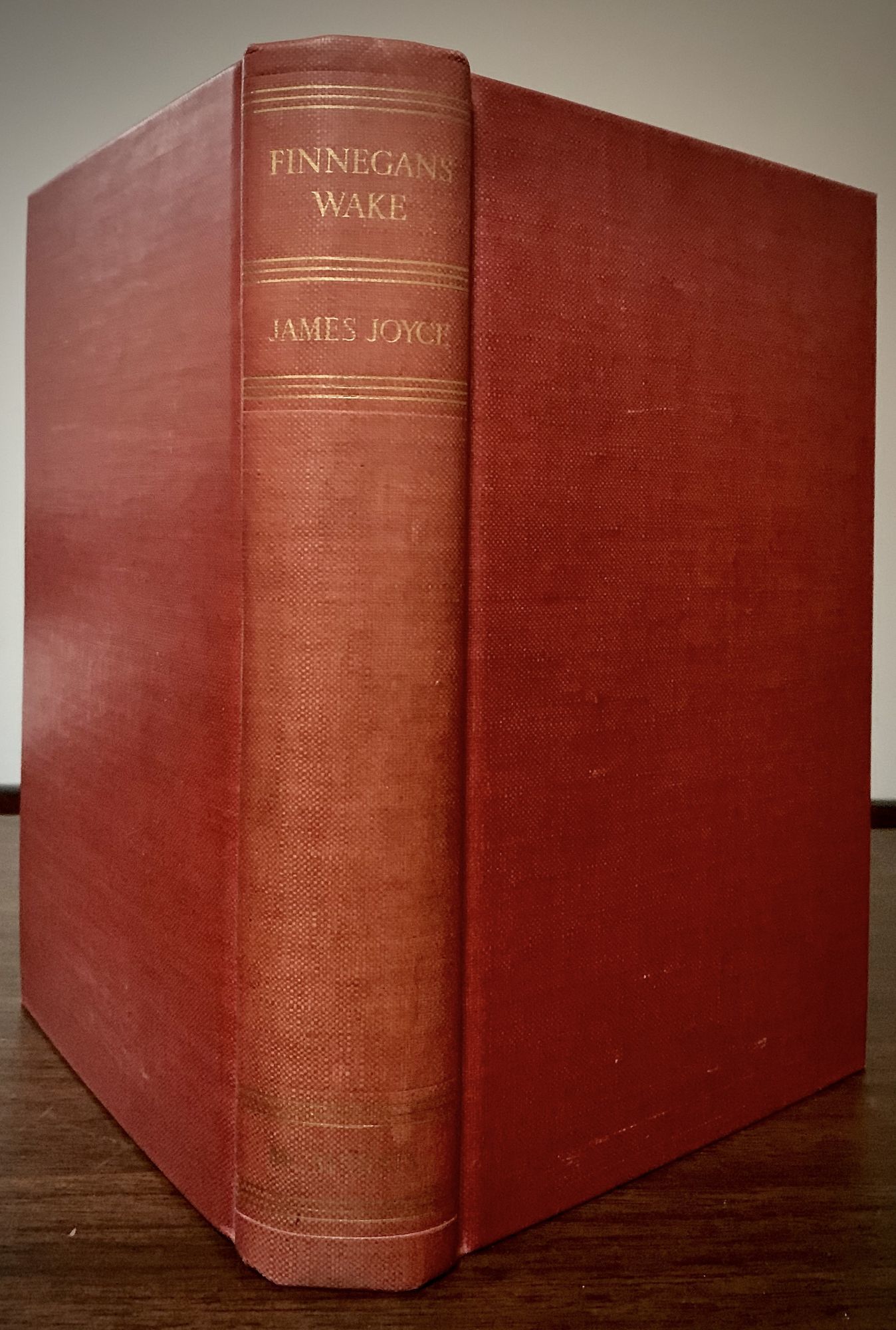
London & New York: Faber & Faber Limited & The Viking Press, 1939. First edition. Hardcover. Orig. publisher's orange/red buckram, backstrip lettered in gilt. Fine in the original yellow cloth slipcase as issued. Teg. 628 pages. 26 x 17 cm. Limited edition, copy 22 of 425 signed by James Joyce in green ink. Joyce wished to puzzle critics with his novel's plot which is not nearly as complex as the linguistic tactics he employed, and he did both. Finnegans Wake met with mixed review: some said it was unreadable, others praised Joyce for ingenuity. Joyce combined use of a number of languages with complex ironic implications to create wordplay and hidden meaning throughout this work. His polyglot idiom of puns and portmanteau words was intended to convey the relationship between the conscious and the unconscious. The density and layers of meaning have induced scholars to dedicate a good portion of their lives studying it. The critic and scholar Richard Ellman was best known for his literary biography of Joyce noted, "In his earlier books Joyce forced modern literature to accept new styles, new subject matter, new kinds of plot and characterization. In his last book (Finnegans Wake) he forced it to accept a new area of being and a new language." Connolly: The Modern Movement 87. Slocum & Cahoon A49. Slight spine fading, some minor soiling to slipcase.
Offered by Roy Young Bookseller.
The Lord of the Flies
by GOLDING, WILLIAM
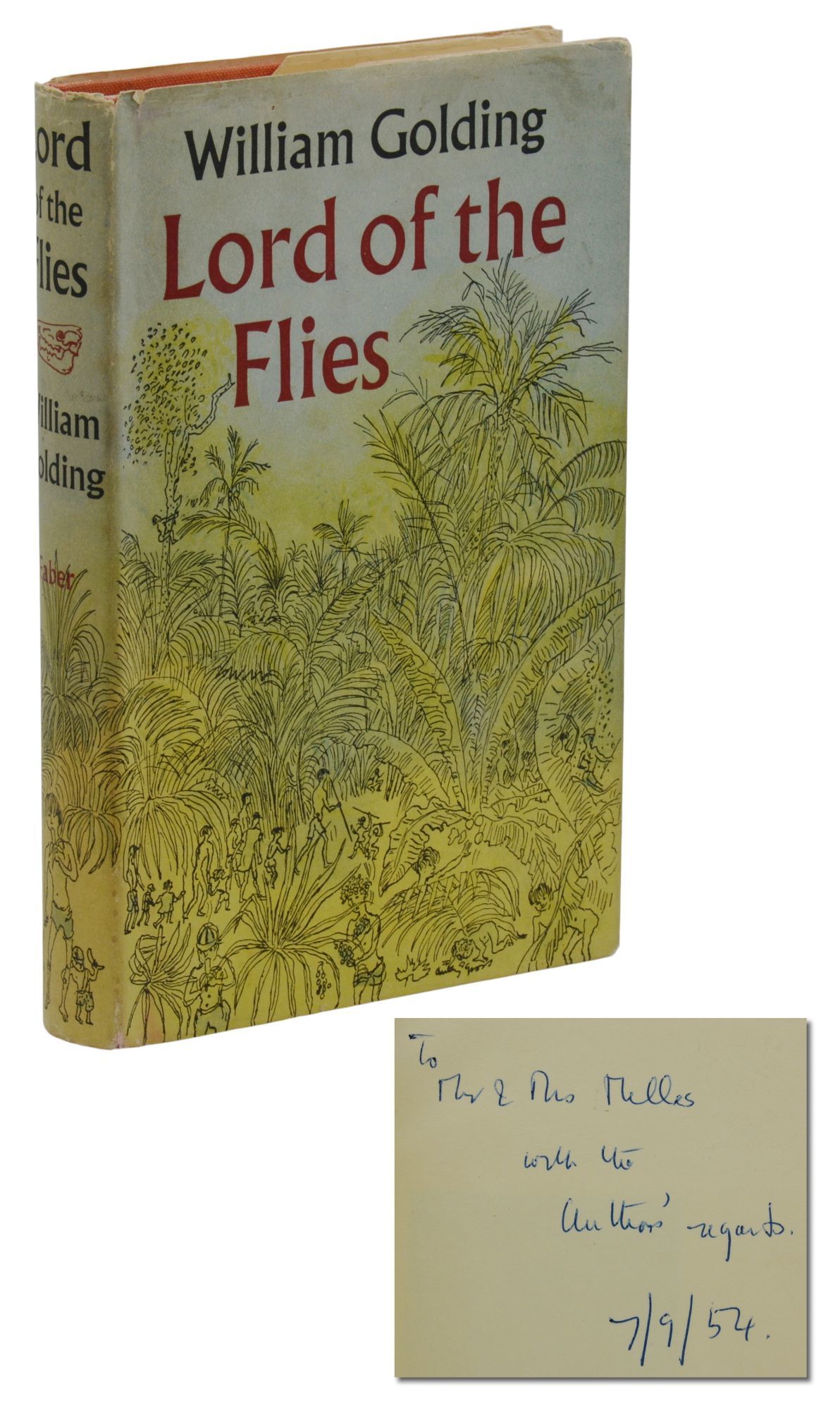
London: Faber and Faber, 1954. First Edition. Near Fine/Very Good. First edition, first printing. An advance presentation copy inscribed by William Golding to his next-door neighbors and dated ten days before publication, reading "To Mr and Mrs Nelles with the author's regards 7/9/54" with his name not signed. Bound in original red cloth with titles in white on spine. Near Fine with slight fading to cloth, bleeding to edges of front paste down and several tiny spots to textblock edge. In a Very Good or better unclipped dust jacket with light bleeding from cloth to blindside, light waviness to front panel, light edge wear, short tear at bottom of front spine joint and two short splits to rear spine joint. An allegorical tale of children stranded on a coral island and their disastrous attempt to govern themselves. It was Golding's first novel, who was a middle-aged school teacher when he wrote it. After reading an unrealistic story of stranded youth, he commented to his wife he could do better. He drew upon on his experience as a school teacher, and at one point even divided the children into two groups and told them to fight each other and observed. The manuscript was rejected by many publishers, and even the book's publisher Faber and Faber initially rejected it as well. A lovely association copy from a then-unknown British school teacher on the cusp of becoming a major novelist, inscribing a copy of his soon-to-be published book to his next-door neighbors. The novel would become a titan of twentieth-century literature and would be named as one of the Modern Library 100 Best Novels, ranked number 41 on the editor's list and 25 by readers. In 1983, Golding was awarded the Nobel Prize in Literature "for his novels which, with the perspicuity of realistic narrative art and the diversity and universality of myth, illuminate the human condition in the world of today.
Offered by Burnside Rare Books.
Foundation Trilogy SIGNED AND INSCRIBED BY AUTHOR ( Foundation, Foundation and Empire, Second Foundation)
by ASIMOV, ISAAC
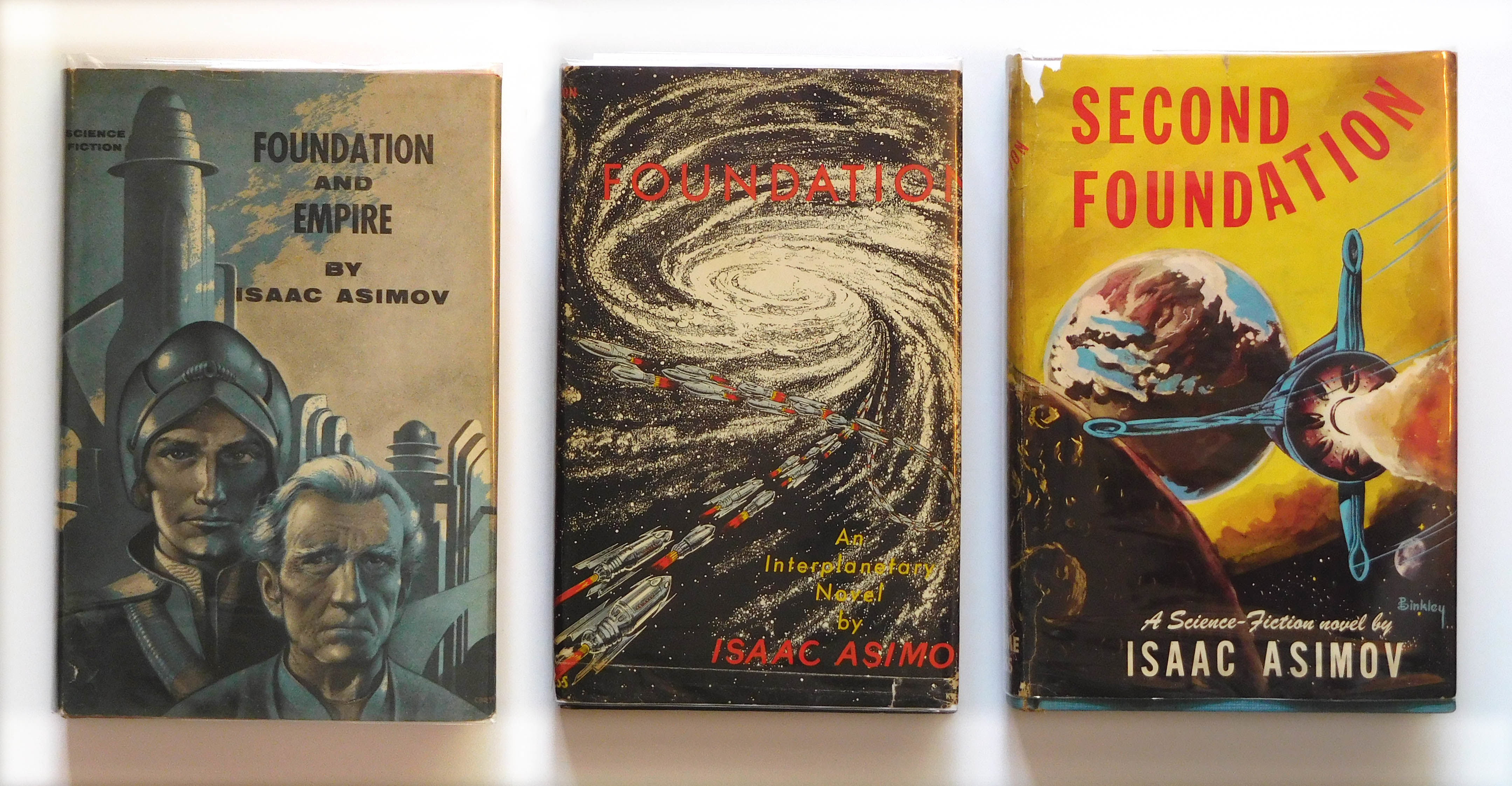
New York: Gnome Press, 1951. An exceptional and RARE set, all three books having been SIGNED AND INSCRIBED BY AUTHOR Isaac Asimov to the same lady in the most intriguing and charming manner - "Foundation" SIGNED AND INSCRIBED "For Laura Jean a passionate Southern gal Isaac Asimov", "Foundation and Empire" SIGNED AND INSCRIBED "For Laura Jean a persistent Southern gal Isaac Asimov", and "Second Foundation " SIGNED AND INSCRIBED "For Laura Jean a married Southern gal Isaac Asimov". Ah, to have been a witness to THAT book signing, where the sparks were obviously flying ! All three books stated Gnome Press First Editions, "Foundation" in dark blue boards with red lettering at spine, thinner and narrower paper and with dust jacket too large for this thinner book, although stating First Edition 1951 on CP is actually the 1954 2nd Edition. Book is Very Good, pages browning, slight toning to edges of end pages, top edge dusty, in a Very Good dust jacket, priced $2.75 front flap, small chips at spine ends and flap fold tips. "Foundation and Empire", 1952, is First Edition, First State in original red cloth, in Second Issue dust jacket in blue tones. Book is Very Good, pages uniformly browning. In Near Fine dust jacket, small chips top and bottom edges rear panel at spine. "Second Foundation", 1953. is First Edition, First State in original light blue boards, spine stamped in brown, Very Good, cloth a bit rubbed at spine ends, light toning to end pages at edges, top edge soiled, in a Very Good dust jacket, 1/2" chip top edge front panel at spine, light edge wear and soiling. Overall a Very Good set, with unique Asimov inscriptions, of this towering classic of the science fiction genre that continues to remain fresh and current. . SIGNED AND INSCRIBED BY AUTHOR. First Editions. Cloth. Very Good/Very Good. Illus. by David Kyle, Edd Carter, and Ric Binkley . 8vo - over 7¾" - 9¾" tall. Presentation Copy.
Offered by Dale Steffey Books.
Atlas Shrugged
by RAND, AYN

New York: Random House, 1957. First edition. Original cloth, original dust jacket. Fine/Fine. FIRST EDITION, FIRST ISSUE of Rand's masterpiece; INSCRIBED BY RAND TO LUDWIG VON MISES: "To Dr. and Mrs. Ludwig von Mieses- / -Cordially- / Ayn Rand / 8/22/57". A spectacular association copy linking two of the most influential economic figures of the twentieth century. In August 1957 - nearly two months before the book was available to the public - Rand presented this copy of the first edition of Atlas Shrugged to Ludwig von Mises (sometimes spelled "von Mieses"), the Austrian-American economist and philosopher who was one of the leading figures of the modern libertarian movement, and immediately found a sympathetic ear.
After reading Atlas Shrugged, von Mises wrote to Rand, offering strong praise for the book. In a letter to Rand dated January 23, 1958, he wrote:
"... I enjoyed very much reading Atlas Shrugged and... I am full of admiration for your masterful construction of the plot. But 'Atlas Shrugged' is not merely a novel. It is also-or may I say first of all-a cogent analysis of the evils that plague our society, a substantiated rejection of the ideology of our self-styled 'intellectuals' and a pitiless unmasking of the insincerity of the policies adopted by governments and political parties. It is a devastating exposure of the 'moral cannibals,' the 'gigolos of science' and of the 'academic prattle' of the makers of the 'anti-industrial revolution.' You have the courage to tell the masses what no politician told them: you are inferior and all the improvements in your conditions which you simply take for granted you owe to the effort of men who are better than you.
"If this be arrogance, as some of your critics observed, it still is the truth that had to be said in this age of the Welfare State.
"I warmly congratulate you and I am looking forward with great expectations to your future work."
The intellectual and philosophical bond between Rand and von Mises remained strong and the Ludwig von Mises Institue notes that "it was largely as a result of Ayn's efforts that the work of von Mises began to reach its potential audience" (Roderick Long).
Ayn Rand inscribed this copy on August 22, 1957, while the book was not available to the public until October 10, 1957, making this one of the earliest known inscribed copies. (We've located two other copies - inscribed to Cecil B. DeMille and Liln E. Rogers, the mother of Ginger Rogers, - inscribed on the same day.)
A remarkable association linking two of the most important defenders of classic liberalism of the 20th century.
New York: Random House, 1957. Thick octavo, original green cloth, original dust jacket; custom box. Only the most trivial wear.
A beautiful copy, and one of the most significant copies, of one of the most influential books of the century.
Offered by Manhattan Rare Book Company.
ABAA Glossary of Rare-Book Terms
Confused by the terms used to describe rare books? Come across abbreviations you're unfamiliar with? Consult the ABAA Glossary of Rare-Book Terms to discover exactly what terms like "first edition," "solander case," or "three-quarter binding" actually mean.
